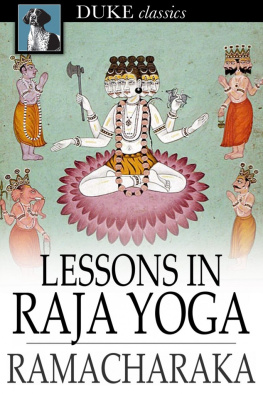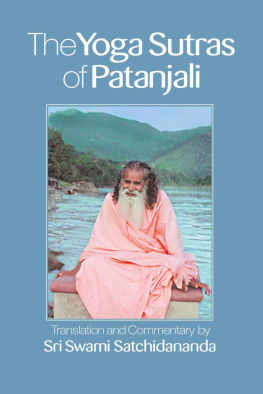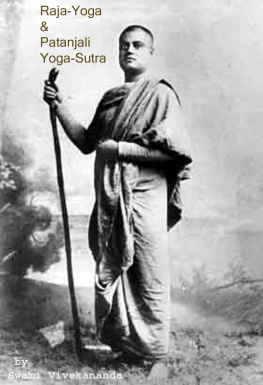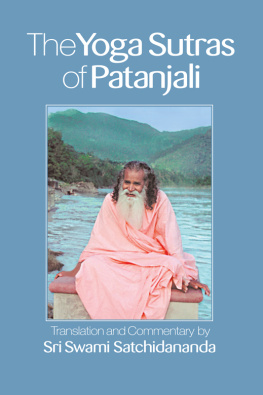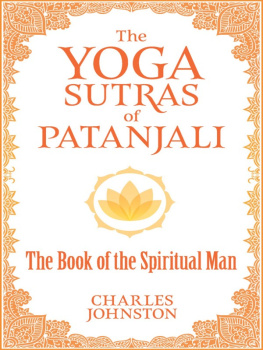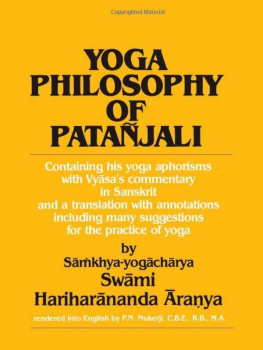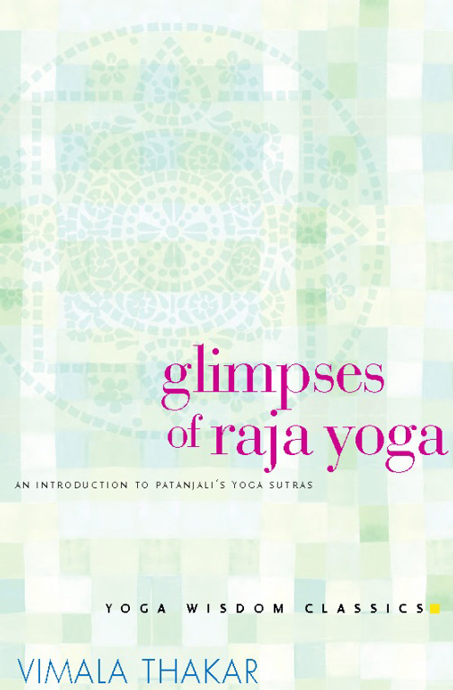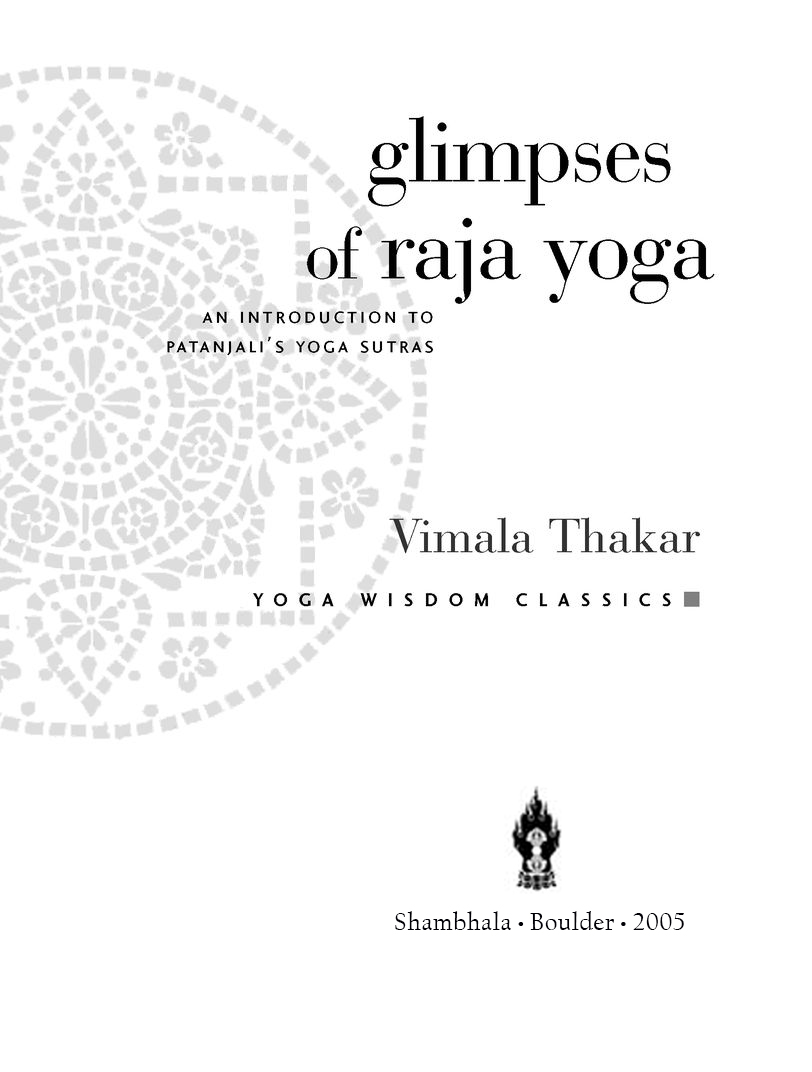Table of Contents
Praise for Glimpses of Raja Yoga
Despite yogas popularity, many students are unaware of the depth of its philosophy, its roots, and its applications. Vimala Thakar offers a remedy in Glimpses of Raja Yoga: An Introduction to Patanjalis Yoga Sutras. With scrupulous attention to language, she presents a clear interpretation of yogas timeless principles in ways that inspire and encourage. A careful reading will provide a better understanding of the basic concepts of yoga philosophy and, more important, help you to live your understanding.
Judith Hanson Lasater, Ph.D, P.T., author of
30 Essential Yoga Poses: For Beginning Students and Their Teachers
By Vimala Thakar
Blossoms of Friendship (2003)
Glimpses of Raja Yoga (2005)
Preface
At the request of friends who are yoga teachers in Italy, Vimalaji gave a series of talks and answered a number of questions on Patanjalis Raja Yoga, in Italy in 1989.
Outside India, Vimalaji has never spoken about yoga or about the Upanishads with non-Indians. It was in March 1989 when some friends from Italy came over to Mount Abu and spent ten days studying Ishavasya Upanishad, that Vimalaji first spoke about the Upanishads, and after Ishavasya Upanishad, in August 1989 Vimalaji spoke about Raja Yoga in Italy.
As such talks on the ancient teachings of Indian sages and rishis are being published for the first time in English, we would like to draw the attention of all our readers, inquirers, and students of yoga to the fact that during the talks Vimalaji clarified that what was being said was about Patanjali Yoga. Vimala is not sitting here to talk about her understanding of life. She is sitting here as a teacher would sit in a class to talk about Raja Yoga, which is a philosophy of Patanjali. So with great respect I share my understanding of those aphorisms.
As these dialogues were a response to questions on different sutras, they were in no way a complete study of the Yoga Sutras. In 1996 there was a request from the Yoga teachers of Europe for an in-depth study of Patanjalis Yoga Sutras. Vimalaji accepted their request and in September 1996 for two weeks Vimalaji took up the study of Patanjalis Raja Yoga. We are happy to inform our readers that a book has now been published based on those dialogues titled Yoga Beyond Meditation.
Kaiser Irani
Editor
CHAPTER ONE
The Foundation of the Science of Raja Yoga
During this one week that we are together, discourses will not be given, but there will be a very intimate sharing about Raja Yoga, which is a holistic way of living. As you consider yourself to be students of yoga, Vimala considers herself a student of the holistic way of living, so we are going to share, sitting in a class, as it were, and talk things over, as intimately as possible.
Let us lay the foundation for our one-week inquiry in this, our first morning session. Im afraid I will be obliged to use a number of Sanskrit terms. One would like to avoid using them, as far as possible, but certain terms would not be avoidable. We have to look at them and understand them before we proceed with our study of Raja Yoga.
Yoga as a way of living was discovered in India thousands and thousands of years ago. It is not a philosophy or a science that came into existence only in 553 B.C., when Patanjali codified the way of living into certain sutras. The study of the sutras by themselvesthe words, their literal meaningis an introduction to yoga, but the aphorisms, or the sutras, of Patanjali do not constitute the whole of yoga.
In order to understand Patanjali, we will have to go back into Vedic history or, rather, the history of Vedic culture in India. In order to lay the foundation of inquiry, you will have to get acquainted with the culture in which Patanjali could write down those aphorisms. Discoveries have their roots in culture.They are not born in the emptiness or void, but are rather the by-products of a collective way of living. Long before Patanjali was born, the Vedas were written. Even if you accept the European version of Indian history, the Vedas were written ten thousand years ago. According to the Chinese and the Indian historians, the Vedas go back fifteen thousand years.
History of the Vedic Period
The word veda is derived from the root vid. Vid is to knowvid, veda, vednta. Vednta is the ending of knowledge. Veda is the product of knowledge. Vid is to know, to acquire information about cosmic life, to investigate through observation, exploration, experimentation and then to write down the truth that has been verified by oneself in the laboratory of ones life.
I would like your attention to be drawn to this point, that in the Vedas, the words that were written are communications of verified truths by the rishis or the sages (by whatever means they had for verification) in the laboratory of their physical and psychological lives. They investigated, explored, experimented and in the laboratory of relationships the truths were verified, because the validity of truth can be discovered only in the movement of relationships. If the truths do not stand valid or stand the test of living them in the actual movement of relationship, then the truths are nothing but theories gathered intellectually, stored in memory, and repeated like philosophies.
The Vedas are not volumes of philosophythey are freely verbalized and written-down communications of the verified truth. That is the first thing one would like to point out about the Vedic culture and the Vedas. The Rig Veda,Yajur Veda, Sama Veda, Atharva Veda were verbally communicated. They had no paper or printing press, so they would take the bark of a tree and write on it. The oldest copies of the Vedas are still on these barks of trees. The name of the tree was bhuja and the bark was called bhoja. On the bhoja patrathe bark of the bhuja treethe Vedas were written.
Rishis
The Vedas are a collection of communications of verified truths, and these truths are about the origin of the cosmos and cosmic life.They are about the nature of interrelationships among the things and beings that inhabit the cosmos, the nature of nonhuman and human species.They are about biology, physiology, psychology, sexology, genetic engineering, music, dance, drama, poetry, to mention only a few. There is not a single aspect of lifehuman as well as nonhumanthat was not investigated by those ancient sages who were called rishis.The Sanskrit word for a sage was i.
The person was called a rishi because the word i is derived from the Sanskrit root that implied to perceive. A rishi is an individual whose perceptions are purified.
In English you call such a person a sage, but the word
sage does not have the nuances contained in the word
i. i means purified perception, austerity to live the perception as it has taken place, and the capacity to teach if students come to them. A rishi must have these three things:
Purified perception (yo mantradro). They perceive.They can perceive the sound and the quality of sound, they can perceive light and the constituent principles of light, they can perceive even where perceptions are subtle, fine, purified.
The strength of austerity or, rather, the strength to dedicate ones life to the living of truth.You might perceive the truth but not live it. Then you cannot be called a rishi.The living is the test of the understanding. Knowledge for the sake of knowledge, knowledge for the sake of scholarship, knowledge for propagation of theoriesall were meaningless in the Vedic period. So they required the discipline, the austerity, to live those truths, to dedicate their lives to living the truths.


